Effects of Earth's Revolution on Life (Summary of Material)
Loading...
Did you know that the Gregorian calendar that we commonly use today is based on the effects of the earth's revolution?
now it turns out, besides that, there are still many consequences of the earth's revolution that can affect survival.
But before we discuss further, you need to know the meaning of the earth's revolution itself. Listen carefully to the review below until it's finished!
list of contents
Understanding the Effects of Earth's Revolution
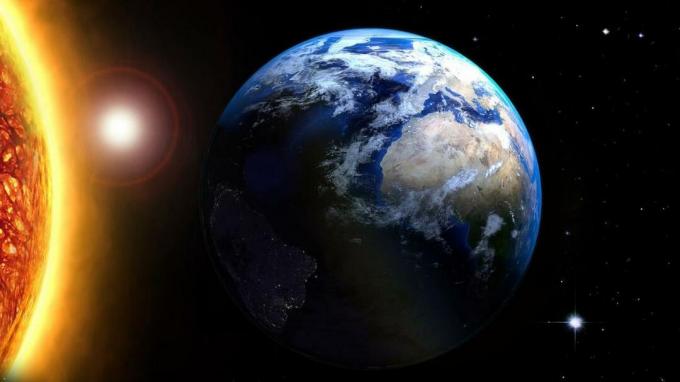
Earth's revolution is the rotation of the earth around the sun.
In one revolution, the earth takes about 365 days 6 hours 9 minutes 10 seconds (one year).
When it is evolving, the earth will follow a trajectory known as earth orbit.
Earth revolves at an inclination of 23.5 degrees in the plane of the ecliptic. The calculated angle is measured along an imaginary line connecting the north pole to the south pole, it is called axis of rotation.
In revolving around the sun, the earth has its own orbit, the orbit is in the shape of an ellipse.
An orbit is a fixed and regular path of an object that revolves around another object.
In a revolution, the earth will not be able to get off track because each planet has its own orbit.
The orbit is also one of the determinants of the length of time to evolve. The further away from the sun, the longer it will take the planet to evolve.
Benefits of Earth Revolution
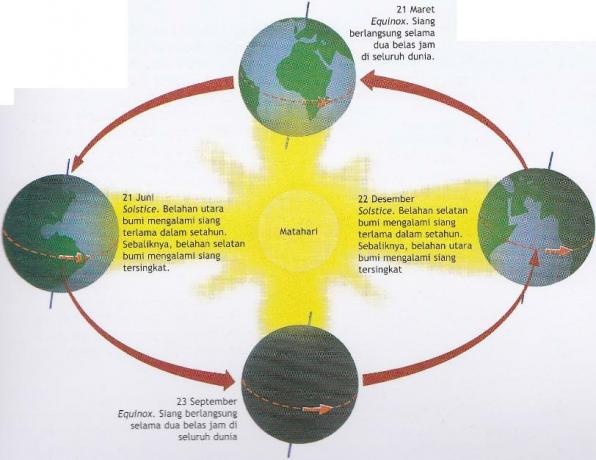
The following are some of the benefits of the effects of the earth's revolution that you need to know, including:
1. Seeing the Various Shapes of the Constellations
With the different constellations, it will bring up what is called the zodiac.
Zodiac is believed to be used to determine a person's fate based on their date of birth.
That way, people with this zodiac sign can be more alert or know about the problems they want to face.
Regardless of whether this is true or not, astrology (the study of fortune-telling based on constellations) can be used as entertainment.
There are even some people who take advantage of the constellations as a livelihood.
2. Feel the Changing of the Seasons
Seasons are conditions or weather that greatly affect human life. Where the season will determine the environmental conditions that will be felt by humans.
These seasons are autumn, summer, winter and spring.
Each season can come and go according to the position of the earth on the sun.
Each season has its own characteristics, for example is summer.
When summer comes, then you can feel the sun is very hot and the temperature will feel very hot.
Then when autumn arrives, then you can see various trees dropping their leaves so that the environment will appear brownish yellow.
When winter comes, you can feel the cold air piercing the bones and you can also find snow everywhere.
As for spring, then you can see trees starting to bloom and flowers blooming with warm air.
The presence of these various seasons will certainly complement each other. With the revolution of the earth, you can feel the sensation of the seasons changing every period.
3. Have a definite unit of time
The benefits that are most felt from the effects of the earth's revolution are related to time or calendar.
Until today, we use a calendar known as the Gregorian calendar.
The Gregorian calendar is based on the revolution of the earth around the sun.
The largest unit of the calendar is the year.
One year AD has a period of one revolution of the earth, which is 365 days.
With the year, you can also recognize the month and date as a smaller unit of time.
5 Impacts of Earth's Revolution
The following are 5 impacts of the revolution that are important for you to know, including:
1. Difference Between Day & Night Time Frequency
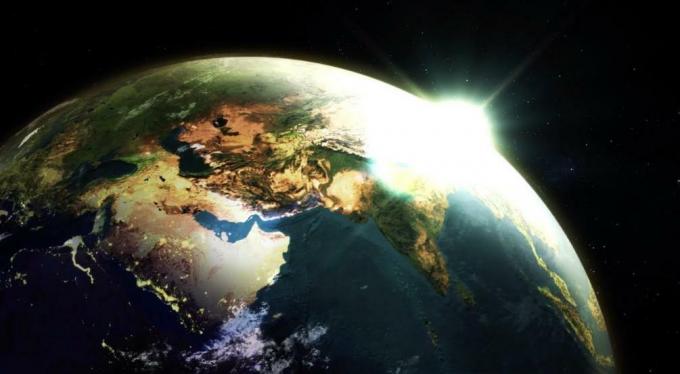
The time of day and night in the northern and southern parts of the earth will be different from the part of the earth located at the equator.
In the middle of the earth or the equator, there are 12 hours of day and night which are evenly divided.
The combination of the revolution and the axis of the earth's tilt is what triggers natural phenomena in the frequency of day and night.
The more towards the north the frequency of day and night will feel longer, even the southernmost part will feel it.
a. March 21 – September 23
Between March 21 and September 23, the sun will begin to move toward the north pole and away from the south pole.
At that time, the northern earth will receive more sunlight. This will cause the frequency of time during the day in the northern hemisphere is longer than the southern hemisphere.
On the equatorial side, the sun will appear to be moving north by 23.5 degrees on June 21.
Some areas in the northern hemisphere will have 24 hours of daylight. And some areas in the southern hemisphere will experience night for 24 hours.
b. September 23 – March 21
Then on September 23 - March 21 will take place the opposite of the previous time.
The south pole area will experience more sunlight than the north pole.
The frequency of daylight hours in the Southern Hemisphere will be longer than that of the Northern Hemisphere.
c. December 22
Then on December 22, the sun will move towards the southernmost earth by 23.5 degrees.
This will make the South Pole region experience 24 hours of daylight. And the North Pole experiences 24 hours of night.
d. March 21 and September 23
Then only on March 21 and September 23 the sun will be at the same distance between the north and south poles.
Earth's north and south will receive the same amount of sunlight.
This will make the length of day and night in all parts the same.
At the equator the sun is directly overhead at this one time.
2. Seasonal Change
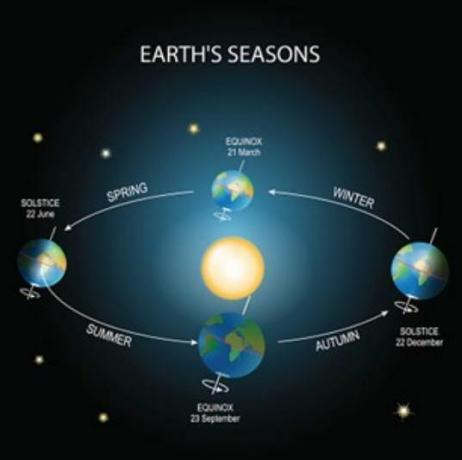
The impact of the earth's revolution will also have an impact on the change of seasons and the difference in seasons in every part of the world.
In the northern and southern hemispheres there are four seasons that change at each time of year.
But this is different from the hemisphere through which the equator passes. Where in this section will only have two seasons, namely the dry season and the rainy season.
The change of seasons is seen from certain dates.
Where at the turn of the seasons, the north and south of the earth have differences because the sun cannot illuminate all parts of the earth.
a. March 21 – June 21
From March 21 to June 21, the sun will begin to appear towards the north.
Where in the northern hemisphere will get more sunlight. At that time in the northern earth will experience spring.
While in the southern hemisphere will get less sunlight.
At that time the area will also experience autumn.
Both take place at the same time, but with different seasons.
Advertisement
b. 21 June – 23 September
Then entering the date of June 21 - September 23, the sun will begin to be in the northernmost part of the earth.
The northern sun's rays will begin to increase. At this time the northern hemisphere is experiencing summer.
And conversely, the sun begins to move towards the northernmost earth, this will make the southern earth get less sunlight. That's when the southern hemisphere experiences winter.
c. September 23 – December 22
Then on September 23 - December 22, the sun will again point towards the equator to the southern part of the earth.
At that time the sunlight in the northern hemisphere will begin to decrease.
Then in autumn takes place in the northern hemisphere.
Meanwhile, the southern hemisphere will get more sunlight. At that time the southern hemisphere was experiencing spring.
d. December 22 – March 21
Finally, on December 22 - March 21, the sun is in the southernmost part of the earth and begins to move towards the north.
This will make the northern earth get less sunlight. At that time, the northern hemisphere will experience winter.
Meanwhile, the southern hemisphere gets more sunlight, where it will experience summer.
The season will continue to rotate until the following years.
The following is a brief explanation regarding the change of seasons during the earth's revolution process:
Southern Earth:
- Spring (September 23 – December 22)
- Summer (22 December – 21 March)
- Autumn (March 21 – June 21)
- Winter (June 21 – September 23)
Northern Earth:
- Spring (March 21 – June 21)
- Summer (June 21 – September 23)
- Autumn (23 September – 22 December)
- Winter (December 22 – March 21)
3. The Sun's Annual Pseudo Motion
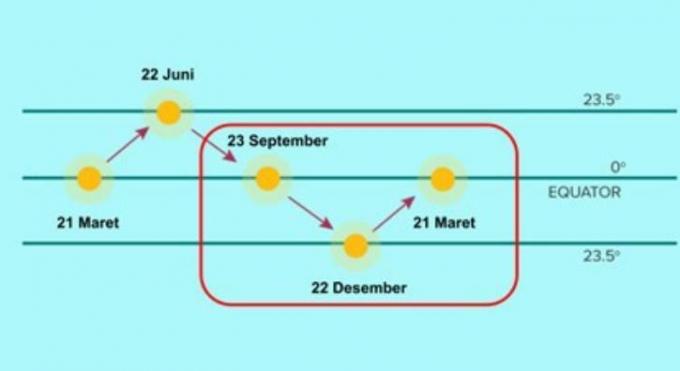
The apparent annual motion of the sun is the background of the changing seasons and the difference in the frequency of day and night on earth.
The entire phenomenon that takes place is due to the position of the sun that changes every month. As a result of the revolution of the earth that will make the position of the sun change.
The part of the earth that gets more sunlight will experience daylight and summer.
And vice versa, if the earth is not exposed to sunlight, it will experience night and winter.
Where the incident will occur repeatedly every year.
As in the picture above, where the motion of the sun always takes place every three months.
- On March 21 – June 21, the sun is located at the equator and begins to move towards the Tropic of Cancer (GBU) by 23.5 degrees.
- Then on June 21 - September 23, the sun will return to the direction of the equator.
- On September 23 – December 22, the sun will move from the equator towards the Tropic of Cancer (GBS) by 23.5 degrees.
- Then on December 22 - March 21, the sun will return again towards the equator.
Why does the sun's annual apparent motion take place?
This is because the earth revolves around the sun or revolution, and rotates on its axis.
Because the earth's axis has a tilt of 23.5 degrees, so that every part of the earth has different sunlight.
When observing this phenomenon continuously, it will appear as if the sun is moving from north to south or vice versa to illuminate the earth.
That is why it is called the annual apparent motion of the sun.
The sun does not really move, but the cause and effect of the earth's revolution will make the sun appear to move. The path in the apparent motion of the sun is called ecliptic.
There are several terms that are closely related to the apparent annual motion of the sun, including:
a. Sun's Declination
It is the angular distance between a celestial body and the celestial equator.
The celestial equator is simply a projection of the earth's equator onto the sky.
It is assumed that the sky has a round shape like the earth.
The declination of the sun can change every day periodically, it can increase or decrease.
The increase and decrease in declination is about 0.9856 degrees per day.
That way, the time it takes the sun to declinate from +23.5 degrees to -23.5 degrees occurs for 182.6211 days.
b. Then Equinoxes
Is a time equal in length between day and night in all parts of the earth.
For people who live at the equator, the frequency of day and night is the same, which is 12 hours.
But not for people who live on the north and south sides of the earth.
For example, for people who live in Europe during winter, they will feel a long night.
Meanwhile, people who live in Australia will feel the summer during the longer days.
Once entered in the equinoxes, then all parts of the earth have the same time frequency.
c. Soltices
When translated into Greek means the sun is fixed.
Called fixed because on a certain date the sun will not move much towards the north or south.
In general, the sun will move from +25.3 degrees to -23.5 degrees and back again to +23.5 degrees.
The equinoxes and soltices occur twice a year, namely on March 21 and September 23 are called equinoxes, then June 21 and December 22 are called soltices.
4. The Gregorian Calendar

The Gregorian calendar was created because of the earth's revolution.
Judging from the division of longitude, the limit of the international calendar is at 180 degrees.
If on the east side of longitude 180 degrees is on the 6th, then on the west side of longitude 180 degrees is still on the 5th.
The incident seemed to be jumping for a day. The Gregorian calendar counts a year with a total of 365.25 days.
The Gregorian calendar was originally used by Julius Caesar otherwise known as the Julian calendar.
Where on the Julian calendar it is calculated from the interval between spring and the next spring on the northern side of the earth. The time interval is exactly 365 days, 5 hours, 48 minutes, 46 seconds.
In his calculations, then Julius Caesar then determined the calculation of the Gregorian calendar as follows:
The time in a year is 365 days, and a day has 24 hours.
Because the 365 days are more than a quarter of a day in each year, it exceeds one day every four years to 366 days.
The logic is like times 4 which results in 1.
A year with 366 days is known as a leap year. Usually takes place in February.
For easy recall, a leap year is a year that is divisible by four, such as 2000, 2004, 2008, and so on.
5. Constellations Formed

Constellations are a group of stars that form a certain pattern.
Actually the constellations that you see are not close to each other.
The location of one star with another is far apart, when observed from Earth it will look close together and the pattern is arranged.
Because of the revolution of the earth, the constellations in each part of the earth will look different.
Earth in the north can only see the constellations in the north, the earth in the south can only see constellations in the south, as well as other parts of the earth.
According to the International Astronomical Union in 1992 there were 88 constellations.
Some of them are:
- Ursa Major,
- Ursa Minor,
- orion,
- Scorpius,
- and Leo.
The various constellations certainly have their own histories.
The stars will give aspirations to all aspects of life and have become part of every culture and art that can stimulate the imagination.
Until then, the stars and their whereabouts will be full of mystery.
Although the stars can be observed more closely using current scientific developments, their glow at night still holds many mysteries.
Conclusion
Earth makes revolutions without stopping with a span of 365 days or can be called a year.
Which means, the earth will take time to circle the earth once with a total of 365 days, one rotation or a year.
At the time of evolution, the earth will continue to run according to its orbit. This is what makes the position of the earth is not always fixed.
This makes the annual apparent motion of the sun where on March 21 the sun lies at the equator.
Then on June 21 the sun is at the Tropic of Cancer (GBU) 23.5 degrees. Then on September 23 back again at the equator.
And on December 22, the sun is located at the Tropic of Cancer (GBS) at 23.5 degrees.
From the apparent daily motion of the sun, it will also cause the change of seasons and the frequency of day and night.
In the northern hemisphere, which is exposed to more sunlight, it will experience summer and longer daylight hours.
Meanwhile, the southern hemisphere will experience winter and a longer night time.
Due to the revolution of the earth this one also makes the appearance of different constellations at different times of each month.
The constellations will also look different in other parts of the earth.
The constellations in the northern hemisphere will be different from the southern hemisphere, as well as in other parts.
Due to the revolution of the earth, also known as the Gregorian calendar.
The Gregorian calendar is divided by 180 degrees. Between parts of the earth with one another as if it would be a day different.
The existence of the Gregorian calendar will also let you know that every four years has a leap year. Which one in February will be more than one day.
X CLOSE
Advertisements
X CLOSE
Advertisements
